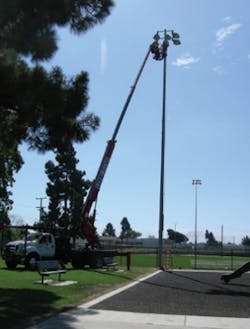Advanced Metering Infrastructure: Drivers and Benefits in the Water Industry
By Angela Godwin, WaterWorld Digital Media Editor
Advanced Metering Infrastructure, or AMI, has become somewhat of a buzz word in the water industry over the last few years and it’s being adopted more and more by water utilities under pressure to increase efficiency. With recent advancements in AMI technology, it’s not hard to see the attraction.
Before embarking on a discussion of AMI technology, it’s important to understand the difference between AMR and AMI, as the terms are often confused. AMR, or Automatic Meter Reading, is essentially a step up from a human being walking over to a water meter, reading the numbers, and writing them down. Rather, a device automatically pings the meter to get a current reading, which is used to generate a bill. AMR systems can be walk-by, drive-by, or fixed network, but regardless of how the meter is read, the communication is one-way. The meter talks to the meter-reading device, but the device cannot send a command back to the meter.
Conversely, AMI enables two-way communication over a fixed network between the utility system and the metering endpoints. It’s a much more powerful and robust system that’s proving its value in some challenging environments, from the rural plains to bustling urban centers.
Historically, AMR systems have been about reading meters quickly and accurately. These systems are certainly useful and continue to be deployed today, but many water utilities are finding that they have challenges beyond simply speed-reading a meter. Utilities are struggling with myriad operational issues that in many cases can be solved by AMI.
Non-Revenue Water Loss
Water utilities across the country are literally leaking money. They take in, treat, and pump water to their customers but can be losing as much 30% of their product along the way to leaks in the distribution system. That’s water that has been treated but will never be billed.
Traditionally, finding leaks has been a manual process. A utility might have a few crews driving around the system in correlator trucks to listen for leaks, and if they find something, they dig it up. But it can take several years to cover an entire distribution system. And, in many cases, by the time a leak is discovered, it could have been leaking for years.
With an AMI system, the whole distribution network can be continuously monitored by hourly interval reads. Recent advancements in meter data management have transformed the vast spreadsheets and tedious data-mining activities of just a few years ago into push-button reports, allowing a water utility to find evidence of leaks before they hit the surface sometimes years before. It can prevent a small leak from becoming a big leak, or worse, a water main break.
“You’ll find a leak when it’s much smaller so you can repair it more proactively rather than having to rush out because the street just opened up and swallowed a car,” said Don Schlenger, vice president of consulting firm SAIC.
Finding leaks earlier means a much less expensive repair. It could be the difference between simply clamping a pipe and replacing an entire section.
Leaks aren’t just detrimental to water utility infrastructure, though, they are a drain on the utility’s pocket book.
Shannon Sweeney, water resources manager for the city of Santa Maria, CA, can attest to the benefits of using AMI to recover lost water.
Her water utility began converting a portion of its system to fixed base AMI in December 2009. At the end of one year, with only a third of the utility’s 20,000 water connections converted, Santa Maria was able to reduce its non-revenue water loss from 6% down to 2%.
“That 4% of unaccounted-for water is at least $600,000 in recovered revenue for us,” she said. “It’s water we produced but were never getting any revenue from.”
While any water utility would like to recover unaccounted-for water, it has particular significance for systems that are subject to supply constraints, such as in California.
“They’re looking at their non-revenue water pretty hard,” said Schlenger. “AMI is a real game changer in terms of doing things like that.”
Asset Management
Water systems are typically underground, making it difficult to know the condition of its distribution system. But if a water utility has insight into how different parts of its distribution system are performing, such as AMI can provide, it can better focus its attention on the pipes in most need of repair. This helps the utility better allocate resources by extending the life of capital assets.
Conservation
Conservation is another concern driving water utilities to take a good look at AMI.
“Conservation is really important,” said Schlenger. “AMI is a tremendous tool for conservation managers and they’re learning how to use it in cool ways.”
For example, it can be used with budget rates and budget billing. A utility in a water-stressed area might have customers on a personalized budget rate for a particular household size. If a customer exceeds his allocation, he could be subject to a higher per-gallon charge or penalty.
“That’s all well and good, but if you’re only getting a bill once a month, you’ve already messed up,” said Schlenger. But if the utility can tell the customer how he’s doing against his budget on a day-to-day basis, there’s instant feedback. “That really energizes budget rates as a useful tool for conservation.”
That sort of feedback can be a very powerful tool for homeowners. A study conducted by IBM and the city of Dubuque, IA, using an AMI system from Neptune, looked at how access to daily consumption data affected water usage habits. It found that the group that had access to daily usage profile data was much more likely to change their consumption habits than the control group that did not.
Sustainability
“We’re starting to see business cases where people want the triple bottom line: economic, environmental and social,” said Schlenger. AMI is helping water utilities achieve that.
Not having to manually read meters or physically investigate a high water bill complaint means not having to roll a truck. This results in cost savings on gasoline and vehicle maintenance, plus a lower carbon footprint.
Workforce Management
Using AMI to automate many of the traditionally manual functions of water utility staff enables the utility to transition its workers into more critical roles. Sweeney said that because her meter readers are now off the street, her lean utility is able to tackle other projects that they didn’t have the resources for previously.
Furthermore, over the next 10 to 15 years, water utilities are expecting a large portion of their workforce to retire. With that impending drain on resources, it’s becoming more important than ever to strategically manage staff.
Customer Service
For a municipal water system where customers are also constituents, customer service is critical. With the detailed usage data available in an AMI system, customer service representatives have immediate access to consumers’ consumption information. When a customer calls with a high water bill complaint, the CS representative can give him a complete picture of how and when he’s using water.
“I’m telling you, it’s a pretty powerful thing when somebody calls and says there’s no way the meter is right,” said Sweeney, “and I say, ‘You are an early riser. I see you take a shower at 5 AM.’”
The ability to communicate this level of information to the customer not only adds validity to the accuracy of the meter, it makes for superior customer relationships when you cancquickly resolve their questions.
The customer isn’t the only one feeling satisfied. “As a customer service representative, you’re trying to help someone with a problem,” said Schlenger. “Nine times out of ten, you’re reacting to unpleasantness.” This takes a tremendous toll on customer service reps. But being able to investigate, diagnose and solve a customer’s problem, changes the CS rep’s perspective.
“When you really feel you can help customers and be proactive, then your whole feeling about your job changes,” said Schlenger. “It becomes more enjoyable and you have more time as an organization to start being analytical.”
“Our customer service workload has shifted dramatically,” said Sweeney. “And my staff is happier because now we are finally getting to the workload that we know exists but never had the time to do before. It really has revolutionized how we operate our water distribution system.”
Evolution
AMI systems continue to evolve. One the most significant advancements might be time synchronization. This enables the AMI system to essentially take a snapshot of a water utility’s distribution system at a given point in time, giving a complete image of consumption. This allows water managers to look at inflows and outflows, for example, and perform comparative analysis on the distribution system. From that, they can see when water is flowing and where there might be stresses on the system.
Going forward, AMI systems are on track to incorporate more systems integration, where AMI data is feeding the GIS system, the work management system, the document management system, and the billing system. When all those systems are talking to one another, that’s when we’re likely to begin seeing the ‘smart water system’ defined.
For now, water utilities large and small are finding out how AMI systems can help them improve operations.
“I have spent a lot of time championing this cause because I do believe in all of the benefits,” said Sweeney. Not only does she believe in the benefits but she’s been able to quantify them.
“I’ve been able to show that it is going to pay for itself,” she said. “And who can argue with a system that pays for itself?”
WW
More WaterWorld Current Issue Articles
More WaterWorld Archives Issue Articles


